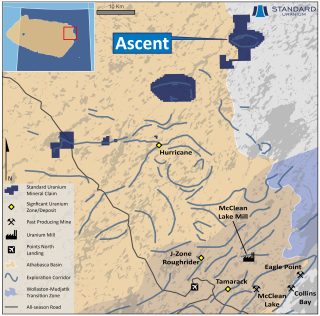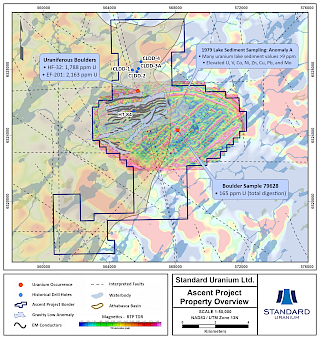Ascent Project
Standard Uranium holds a 100%-interest in the Ascent project which straddles the eastern boundary of the Athabasca Basin. The recently expanded project consists of four mineral dispositions totalling 7,465 hectares.
As the property lies on the edge of the Basin, depth to the sub-Athabasca unconformity is known to be approximately 50 metres from surface at maximum, while the eastern portion of the project has no Athabasca sandstone cover.
Historical airborne EM work in 1979 and 2006 has identified one large, 6-km long and 3-km wide conductive corridor with numerous target areas related to potential cross structures. In the early 1980s the area was covered with ground EM surveys which confirmed the airborne targets.
Additionally, a 1979 lake sediment sampling program identified a very high-priority Radon-U-Co-Ni-Zn-Mo-Pb-V anomaly located immediately above the conductive target. Only one drill hole (HT-84), completed in 1984, has tested the extensive conductive corridor with 6 km of strike length remaining un-tested and ready for further exploration.
Regional prospecting by historical operators also identified uranium enrichment in basement rocks located east of the Athabasca Basin edge, which support the exploration model for shallow sandstone and basement hosted uranium on the property. The high-resolution TDEM survey completed by the Company in 2022 has further resolved shallow geophysical conductors on the project, defining several priority drill targets for an inaugural drill program on the project.
The current exploration model for the Ascent project is analogous to that of the J-Zone and Roughrider deposits, that are located proximal to a similar airborne EM target that has dimensions of roughly 2-km long by 1-km wide. The Ascent EM target is interpreted by the Company to represent a shallow-dipping conductive system and will be the focus of future exploration programs, drawing on the analogy of the J-Zone and Roughrider uranium deposits.
Disclosure of Technical and Scientific Information
Except as otherwise noted herein, Sean Hillacre, MSc. P.Geo., Standard Uranium’s VP Exploration, has reviewed and approved the scientific and technical information contained in this website. Mr. Hillacre is a Qualified Person within the meaning of Canadian Securities Administrator’s National Instrument 43-101.


